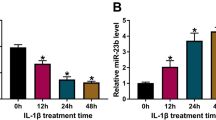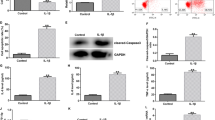Abstract
Osteoarthritis (OA) is a degenerative joint disease characterized by articular cartilage degradation and joint inflammation in which microRNAs are significantly involved. Previous studies have reported that miR-142-3p is a novel mediator of inflammatory signaling pathways, but whether miR-142-3p regulates OA remains unknown. In this study, we aimed to investigate the potential role of miR-142-3p in OA and the underlying molecular mechanism. We showed that miR-142-3p was significantly reduced in the articular cartilage tissues from experimental OA mice. The expression of miR-142-3p was also decreased in chondrocytes treated with lipopolysaccharide (LPS) in vitro. Moreover, the overexpression of miR-142-3p significantly inhibited cell apoptosis, nuclear factor (NF)-kB, and the production of proinflammatory cytokines, including interleukin (IL)-1, IL-6, and tumor necrosis factor (TNF)-α induced by LPS. Interestingly, bioinformatics analysis demonstrated that high mobility group box 1 (HMGB1), an important inflammatory mediator of OA, was predicted as a target of miR-142-3p, which was validated by dual-luciferase reporter assay. The high expression of HMGB1 in chondrocytes induced by LPS was significantly inhibited by miR-142-3p overexpression. Furthermore, the restoration of HMGB1 markedly abrogated the effect of miR-142-3p. In OA mice, the overexpression of miR-142-3p by lentivirus-mediated gene transfer significantly inhibited HMGB1 expression, NF-kB signaling, and proinflammatory cytokines. Moreover, the overexpression of miR-142-3p significantly alleviated OA progression in OA mice in vivo. Taken together, our study suggests that miR-142-3p inhibits chondrocyte apoptosis and inflammation in OA by inhibiting the HMGB1-mediated NF-kB signaling pathway. The overexpression of miR-142-3p impedes the OA progression in mice in vivo indicating that miR-142-3p is a potential molecular target for OA treatment.






Similar content being viewed by others
Abbreviations
- OA:
-
osteoarthritis
- miRNAs:
-
microRNAs
- LPS:
-
lipopolysaccharide
- IL:
-
interleukin
- TNF-α:
-
tumor necrosis factor α
- NF-kB:
-
nuclear factor-kB
- HMGB1:
-
high mobility group box 1
References
Taruc-Uy, R.L., and S.A. Lynch. 2013. Diagnosis and treatment of osteoarthritis. Primary Care 40: 821–836. vii.
Swingler, T.E., G. Wheeler, V. Carmont, H.R. Elliott, M.J. Barter, M. Abu-Elmagd, S.T. Donell, R.P. Boot-Handford, M.K. Hajihosseini, A. Munsterberg, et al. 2012. The expression and function of microRNAs in chondrogenesis and osteoarthritis. Arthritis and Rheumatism 64: 1909–1919.
Goldring, M.B. 2012. Chondrogenesis, chondrocyte differentiation, and articular cartilage metabolism in health and osteoarthritis. Therapeutic Advances in Musculoskeletal Disorders 4: 269–285.
Blanco, F.J., R. Guitian, E. Vazquez-Martul, F.J. de Toro, and F. Galdo. 1998. Osteoarthritis chondrocytes die by apoptosis. A possible pathway for osteoarthritis pathology. Arthritis and Rheumatism 41: 284–289.
Qin, J., L. Shang, A.S. Ping, J. Li, X.J. Li, H. Yu, J. Magdalou, L.B. Chen, and H. Wang. 2012. TNF/TNFR signal transduction pathway-mediated anti-apoptosis and anti-inflammatory effects of sodium ferulate on IL-1beta-induced rat osteoarthritis chondrocytes in vitro. Arthritis Research and Therapy 14: R242.
Vicente, R., D. Noel, Y.M. Pers, F. Apparailly, and C. Jorgensen. 2015. Deregulation and therapeutic potential of microRNAs in arthritic diseases. Nature Reviews. Rheumatology 12(4): 211–220.
Mendell, J.T., and E.N. Olson. 2012. MicroRNAs in stress signaling and human disease. Cell 148: 1172–1187.
Bartel, D.P. 2004. MicroRNAs: genomics, biogenesis, mechanism, and function. Cell 116: 281–297.
Winter, J., S. Jung, S. Keller, R.I. Gregory, and S. Diederichs. 2009. Many roads to maturity: microRNA biogenesis pathways and their regulation. Nature Cell Biology 11: 228–234.
Croce, C.M., and G.A. Calin. 2005. miRNAs, cancer, and stem cell division. Cell 122: 6–7.
Lu, B., C. Wang, M. Wang, W. Li, F. Chen, K.J. Tracey, and H. Wang. 2014. Molecular mechanism and therapeutic modulation of high mobility group box 1 release and action: an updated review. Expert Review of Clinical Immunology 10: 713–727.
Tian, J., A.M. Avalos, S.Y. Mao, B. Chen, K. Senthil, H. Wu, P. Parroche, S. Drabic, D. Golenbock, C. Sirois, et al. 2007. Toll-like receptor 9-dependent activation by DNA-containing immune complexes is mediated by HMGB1 and RAGE. Nature Immunology 8: 487–496.
Yu, M., H. Wang, A. Ding, D.T. Golenbock, E. Latz, C.J. Czura, M.J. Fenton, K.J. Tracey, and H. Yang. 2006. HMGB1 signals through toll-like receptor (TLR) 4 and TLR2. Shock 26: 174–179.
Fiuza, C., M. Bustin, S. Talwar, M. Tropea, E. Gerstenberger, J.H. Shelhamer, and A.F. Suffredini. 2003. Inflammation-promoting activity of HMGB1 on human microvascular endothelial cells. Blood 101: 2652–2660.
Ley, C., S. Ekman, B. Roneus, and M.L. Eloranta. 2009. Interleukin-6 and high mobility group box protein-1 in synovial membranes and osteochondral fragments in equine osteoarthritis. Research in Veterinary Science 86: 490–497.
Heinola, T., V.P. Kouri, P. Clarijs, H. Ciferska, A. Sukura, J. Salo, and Y.T. Konttinen. 2010. High mobility group box-1 (HMGB-1) in osteoarthritic cartilage. Clinical and Experimental Rheumatology 28: 511–518.
Garcia-Arnandis, I., M.I. Guillen, F. Gomar, J.P. Pelletier, J. Martel-Pelletier, and M.J. Alcaraz. 2010. High mobility group box 1 potentiates the pro-inflammatory effects of interleukin-1beta in osteoarthritic synoviocytes. Arthritis Research and Therapy 12: R165.
Li, Z.C., G.Q. Cheng, K.Z. Hu, M.Q. Li, W.P. Zang, Y.Q. Dong, W.L. Wang, and Z.D. Liu. 2011. Correlation of synovial fluid HMGB-1 levels with radiographic severity of knee osteoarthritis. Clinical and Investigative Medicine 34: E298.
Yuan, Z., G. Luo, X. Li, J. Chen, J. Wu, and Y. Peng. 2016. PPARgamma inhibits HMGB1 expression through upregulation of miR-142-3p in vitro and in vivo. Cellular Signalling 28: 158–164.
Xu, G., Z. Zhang, J. Wei, Y. Zhang, L. Guo, and X. Liu. 2013. microR-142-3p down-regulates IRAK-1 in response to Mycobacterium bovis BCG infection in macrophages. Tuberculosis (Edinburgh, Scotland) 93: 606–611.
Gosset, M., F. Berenbaum, S. Thirion, and C. Jacques. 2008. Primary culture and phenotyping of murine chondrocytes. Nature Protocols 3: 1253–1260.
Glasson, S.S., T.J. Blanchet, and E.A. Morris. 2007. The surgical destabilization of the medial meniscus (DMM) model of osteoarthritis in the 129/SvEv mouse. Osteoarthritis and Cartilage 15: 1061–1069.
Pritzker, K.P., S. Gay, S.A. Jimenez, K. Ostergaard, J.P. Pelletier, P.A. Revell, D. Salter, and W.B. van den Berg. 2006. Osteoarthritis cartilage histopathology: grading and staging. Osteoarthritis and Cartilage 14: 13–29.
Luan, Z.G., H. Zhang, P.T. Yang, X.C. Ma, C. Zhang, and R.X. Guo. 2010. HMGB1 activates nuclear factor-kappaB signaling by RAGE and increases the production of TNF-alpha in human umbilical vein endothelial cells. Immunobiology 215: 956–962.
Perri, R., S. Nares, S. Zhang, S.P. Barros, and S. Offenbacher. 2012. MicroRNA modulation in obesity and periodontitis. Journal of Dental Research 91: 33–38.
Pivarcsi, A., F. Meisgen, N. Xu, M. Stahle, and E. Sonkoly. 2013. Changes in the level of serum microRNAs in patients with psoriasis after antitumour necrosis factor-alpha therapy. British Journal of Dermatology 169: 563–570.
Ralfkiaer, U., L.M. Lindahl, T. Litman, L.M. Gjerdrum, C.B. Ahler, R. Gniadecki, T. Marstrand, S. Fredholm, L. Iversen, M.A. Wasik, et al. 2014. MicroRNA expression in early mycosis fungoides is distinctly different from atopic dermatitis and advanced cutaneous T-cell lymphoma. Anticancer Research 34: 7207–7217.
Schaefer, J.S., T. Attumi, A.R. Opekun, B. Abraham, J. Hou, H. Shelby, D.Y. Graham, C. Streckfus, and J.R. Klein. 2015. MicroRNA signatures differentiate Crohn’s disease from ulcerative colitis. BMC Immunology 16: 5.
Boomiraj, H., V. Mohankumar, P. Lalitha, and B. Devarajan. 2015. Human corneal microRNA expression profile in fungal keratitis. Investigative Ophthalmology & Visual Science 56: 7939–7946.
Naqvi, A.R., J.B. Fordham, and S. Nares. 2015. miR-24, miR-30b, and miR-142-3p regulate phagocytosis in myeloid inflammatory cells. Journal of Immunology 194: 1916–1927.
Yamada, Y., K. Kosaka, T. Miyazawa, K. Kurata-Miura, and T. Yoshida. 2014. miR-142-3p enhances FcepsilonRI-mediated degranulation in mast cells. Biochemical and Biophysical Research Communications 443: 980–986.
Sun, Y., S. Varambally, C.A. Maher, Q. Cao, P. Chockley, T. Toubai, C. Malter, E. Nieves, I. Tawara, Y. Wang, et al. 2011. Targeting of microRNA-142-3p in dendritic cells regulates endotoxin-induced mortality. Blood 117: 6172–6183.
Xiao, P., and W.L. Liu. 2015. MiR-142-3p functions as a potential tumor suppressor directly targeting HMGB1 in non-small-cell lung carcinoma. International Journal of Clinical and Experimental Pathology 8: 10800–10807.
Andersson, U., and K.J. Tracey. 2011. HMGB1 is a therapeutic target for sterile inflammation and infection. Annual Review of Immunology 29: 139–162.
Kang, R., R. Chen, Q. Zhang, W. Hou, S. Wu, L. Cao, J. Huang, Y. Yu, X.G. Fan, Z. Yan, et al. 2014. HMGB1 in health and disease. Molecular Aspects of Medicine 40: 1–116.
Terada, C., A. Yoshida, Y. Nasu, S. Mori, Y. Tomono, M. Tanaka, H.K. Takahashi, M. Nishibori, T. Ozaki, and K. Nishida. 2011. Gene expression and localization of high-mobility group box chromosomal protein-1 (HMGB-1) in human osteoarthritic cartilage. Acta Medica Okayama 65: 369–377.
Ke, X., G. Jin, Y. Yang, X. Cao, R. Fang, X. Feng, and B. Lei. 2015. Synovial fluid HMGB-1 levels are associated with osteoarthritis severity. Clinical Laboratory 61: 809–818.
Wahamaa, H., H. Schierbeck, H.S. Hreggvidsdottir, K. Palmblad, A.C. Aveberger, U. Andersson, and H.E. Harris. 2011. High mobility group box protein 1 in complex with lipopolysaccharide or IL-1 promotes an increased inflammatory phenotype in synovial fibroblasts. Arthritis Research and Therapy 13: R136.
Qin, Y., Y. Chen, W. Wang, Z. Wang, G. Tang, P. Zhang, Z. He, Y. Liu, S.M. Dai, and Q. Shen. 2014. HMGB1-LPS complex promotes transformation of osteoarthritis synovial fibroblasts to a rheumatoid arthritis synovial fibroblast-like phenotype. Cell Death & Disease 5: e1077.
Guijarro-Munoz, I., M. Compte, A. Alvarez-Cienfuegos, L. Alvarez-Vallina, and L. Sanz. 2014. Lipopolysaccharide activates toll-like receptor 4 (TLR4)-mediated NF-kappaB signaling pathway and proinflammatory response in human pericytes. Journal of Biological Chemistry 289: 2457–2468.
Weber, D.J., A.S. Gracon, M.S. Ripsch, A.J. Fisher, B.M. Cheon, P.H. Pandya, R. Vittal, M.L. Capitano, Y. Kim, Y.M. Allette, et al. 2014. The HMGB1-RAGE axis mediates traumatic brain injury-induced pulmonary dysfunction in lung transplantation. Science Translational Medicine 6: 252ra124.
Sun, J., S. Shi, Q. Wang, K. Yu, and R. Wang. 2015. Continuous hemodiafiltration therapy reduces damage of multi-organs by ameliorating of HMGB1/TLR4/NFkappaB in a dog sepsis model. International Journal of Clinical and Experimental Pathology 8: 1555–1564.
Author information
Authors and Affiliations
Corresponding author
Ethics declarations
The animal use and experimental protocols were reviewed and approved by the Institutional Animal Care and Use Committee of Weihai Municipal Hospital.
Conflict of Interest
The authors declare that they have no conflict of interest.
ELECTRONIC SUPPLEMENTARY MATERIAL
Below is the link to the electronic supplementary material.
Fig. S1
miR-142-3p has no effect on chondrocyte proliferation. Cells were transfected with miR-142-3p mimic or miR-NC for 48 h and then subjected to MTT detection. # p > 0.05 denotes no significant difference. (GIF 6 kb)
Rights and permissions
About this article
Cite this article
Wang, X., Guo, Y., Wang, C. et al. MicroRNA-142-3p Inhibits Chondrocyte Apoptosis and Inflammation in Osteoarthritis by Targeting HMGB1. Inflammation 39, 1718–1728 (2016). https://doi.org/10.1007/s10753-016-0406-3
Published:
Issue Date:
DOI: https://doi.org/10.1007/s10753-016-0406-3




